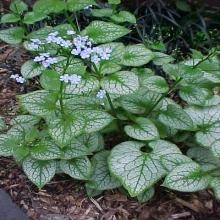The perennial plant of the year for 2012 is Brunnera macrophylla ‘Jack Frost’. It is a patented sport of Brunnera marcrophylla ‘Langtrees’. This plant is familiar to garden club members as it grows prolifically in John Cozen’s garden and he has been most generous in sharing it.
B. macrophylla is known as false for-get-me nots because of its blue flowers that closely resemble those of the true for-get-me not (Myosotis palustris). It also blooms in the early spring about the same time as for-get-me nots. This plant is also known as Siberian Bugloss. It was previously classified as Anchusa myosotidiflora, which placed it in the same genus of the wild bugloss, Anchusa azurea. All, including for-get-me nots, are members of the borage family.
While the delicate blue flowers are pretty, it is the leaves of Brunnera that are the attention getters. They are heart shaped, 3-5 inches across and are silvery white in color. Both large and small veins are a deep green color that is echoed in the green rim around the leaf edge. The striking contrasts in colors make the leaves a focal point in any area of the garden. The color of the leaf is most vivid in a shady situation, which also suits the plant. It grows best in morning sun in the north and in full shade in the warmer climate of the southern reaches of the U.S. Brunnera likes a deep loamy soil and constant moisture. It will tolerate dryer soil in deeper shade and doesn’t seem to mind our clay. It does do better in our area with mulch. The roots aren’t very deep and the mulch seems to compensate for the heavier consistency of our soil. This is by nature a woodland plant native to Eastern Europe and Siberia.
Since one of the native climes of Brunnera is Siberia, it is fully hardy in our area. It is rated as hardy from planting zones 3-7. This puts it well within the criteria of being hardy in a wide range of conditions that is required for consideration as the perennial plant of the year.
 The plant spreads by rhizomes this makes it ideal as a ground cover for those shady areas. It will also re-seed itself but be aware that the cultivars may not breed true from seed. Brunnera doesn’t get much bigger than 12 inches tall, although it can grow to 18 inches under ideal conditions. It is very easy to naturalize. It also makes a nice filler for shady borders where its striking leaves can be used to contrast with bleeding hearts or harmonize with hostas. It draws attention away from daffodils that have finished blooming and serves the same purpose in slightly sunnier locations with day lilies.
The plant spreads by rhizomes this makes it ideal as a ground cover for those shady areas. It will also re-seed itself but be aware that the cultivars may not breed true from seed. Brunnera doesn’t get much bigger than 12 inches tall, although it can grow to 18 inches under ideal conditions. It is very easy to naturalize. It also makes a nice filler for shady borders where its striking leaves can be used to contrast with bleeding hearts or harmonize with hostas. It draws attention away from daffodils that have finished blooming and serves the same purpose in slightly sunnier locations with day lilies.
Brunnera is a relatively carefree plant. It needs little in the way of grooming or fertilizer. The leaves should be left on, as the plant goes into winter so they can give some protection to the roots. They may be cut back in the spring to encourage new growth. The flowers aren’t conspicuous enough to require deadheading but do so if you don’t want the plant to seed. Divide in the early spring every 3-5 years. The clumps tend to die out and dividing will insure a constant supply of plants.
The garden club had so many of these plants two years ago that I stuck them in the ground in an out of the way area where everything is eaten by the deer or groundhogs. They have gone untouched by every critter including snails and will shortly be ready for dividing. With luck we should have a constant stock of this lovely plant for many years to come.